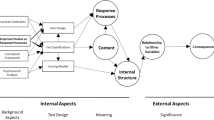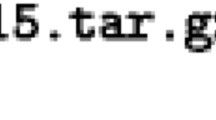Abstract
This study investigated the extent to which observed frequencies of covarying responses could be utilized in the prediction of classroom behavior. Five behavior categories were observed daily over a 12-week period in the regular classroom settings of four fifth-grade and two fourth-grade male students. For each subject, stepwise regression analyses were conducted to determine which behaviors accounted for the largest proportions of variance in a single response category. The proportions of variance explained in the behavior categories of the subjects ranged from 8.9 to 75.4%. Further, response categories serving as predictor variables, as well as the number of predictor variables entered into the equations, differed across subjects. These results are discussed in terms of their implications for behavioral assessment and treatment application.
Similar content being viewed by others
References
Ayllon, T., & Roberts, M. D. (1974). Eliminating discipline problems by strengthening academic performance.Journal of Applied Behavior Analyses, 7 71–76.
Cattell, R. B. (1952). The three basic factor-analytic research designs — their interrelationships and derivatives.Psychological Bulletin, 49(5), 499–520.
Johnson, R. T., & Johnson, D. W. (1981). Building friendships between handicapped and nonhandicapped students: Effects of cooperative and individualistic instruction.American Educational Research Journal, 18 415–423.
Johnston, J. M., & Pennypacker, H. S. (1980).Strategies and tactics of human behavioral research. Hillsdale, NJ: Erlbaum Associates.
Kara, A., & Wahler, R. G. (1977). Organizational features of a young child's behaviors.Journal of Experimental Child Psychology, 24 24–39.
Kazdin, A. E. (1982). Symptom substitution, generalization, and response covariation: Implications for psychotherapy outcome.Psychological Bulletin, 91 349–365.
Kratochwill, T. R. (1978).Single subject research: Strategies for evaluating change. New York: Academic Press.
Lichstein, K. L., & Wahler, R. G. (1976). The ecological assessment of an autistic child.Journal of Abnormal Child Psychology, 4 31–54.
Lovaas, I. O. (1961). Interaction between verbal and nonverbal behavior.Child Development, 32 329–336.
Madsen, C. H., & Madsen, C. K. (1974).Teaching/discipline: A positive approach for educational development. Boston: Allyn & Bacon.
Nelson, R. O., & Hayes, S. C. (1979). Some current dimensions of behavioral assessment.Behavioral Assessment, 1 1–16.
Nordquist, V. M. (1971). The modification of a child's enuresis: Some response-response relationships.Journal of Applied Behavior Analysis, 4 241–247.
Russo, D. C., Cataldo, M. F., & Cushing, P. J. (1981). Compliance training and behavioral covariation in the treatment of multiple behavior problems.Journal of Applied Behavior Analysis, 14 209–222.
Sajwaj, T., Twardosz, S., & Burke, M. (1972). Side effects of extinction procedures in a remedial preschool.Journal of Applied Behavior Analysis, 5 163–175.
Staats, A. W., & Staats, C. K. (1963).Complex human behavior. New York: Holt, Rinehart & Winston.
Voeltz, L. M., & Evans, I. M. (1982). The assessment of behavioral interrelationships in child behavior therapy.Behavioral Assessment, 4 131–165.
Wahler, R. G. (1975). Some structural aspects of deviant child behavior.Journal of Applied Behavior Analysis, 8 27–42.
Wahler, R. G., & Fox, J. J. (1981). Setting events in applied behavior analysis: Toward a conceptual and methodological expansion.Journal of Applied Behavior Analysis, 14 327–338.
Wahler, R. G., Berland, R. M., & Coe, T. D. (1979). Generalization processes in child behavior change. In B. B. Lakey & A. E. Kazdin (Eds.),Advances in Clinical Child Psychology, 2. New York: Plenum Press.
Wahler, R. G., Sperling, K. A., Thomas, M. R., Teeter, N. C., & Luper, H. L. (1970). The modification of childhood stuttering: Some response-response relationships.Journal of Experimental Child Psychology, 9 411–428.
Author information
Authors and Affiliations
Rights and permissions
About this article
Cite this article
Martens, B.K., Witt, J.C. Assessment and prediction in an ecological system: Application of the general linear model to the response-class concept. Journal of Behavioral Assessment 6, 197–206 (1984). https://doi.org/10.1007/BF01321525
Accepted:
Issue Date:
DOI: https://doi.org/10.1007/BF01321525




